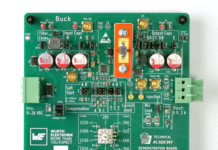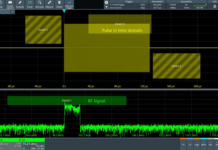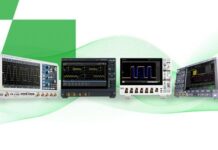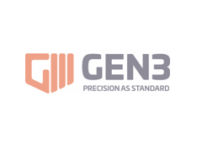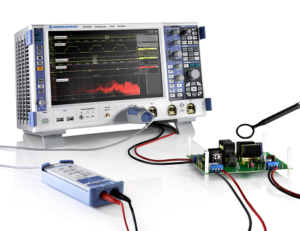
High voltage differential broadband probes allow analysis of switching behavior in fast switching semiconductors. High-sensitivity oscilloscopes with fast FFT functionality combined with near-field probes help developers minimize unwanted EMC emissions in switched-mode power supplies. All-in-one power analyzers enable characterization of energy consumption from µW to kW. Rohde & Schwarz is presenting this portfolio for today’s development requirements in power electronics at the EPE Conference in Riga from September 17 to 21, 2018.
The Rohde & Schwarz range of innovative test and measurement solutions meets the increasing high T&M requirements for power electronics. Large measurement bandwidths are needed to analyze the switching behavior of fast-switching semiconductors, which leads to new challenges in EMC compliance. The extensive Rohde & Schwarz T&M portfolio meets these needs with a selection of products for power electronics.
2 GHz bandwidth for 48 V applications and 200 MHz bandwidth for voltages up to 6 kV
Rohde & Schwarz offers the R&S RT-ZHD series of high voltage differential probes for maximum peak voltages between 750 V and 6 kV. Featuring up to 200 MHz bandwidth, excellent common mode rejection and up to 2000 V offset compensation, the probes are ideal for analyzing the switching behavior of jumpers as well as small ripple voltages on high DC link voltages. The DC accuracy of 0.5 percent, or just 0.1 percent when using the DC voltmeter integrated into the probe, is also exceptional.
High bandwidth measurements on 48 V systems are possible with the 1 GHz R&S RT-ZD10 broadband probe and the 2 GHz R&S RT-ZD20 probe. With the optional R&S RT-ZA15 10:1 attenuator (included as standard with the R&S RT-ZD10), voltages up to 50 V can be measured with an offset compensation range of ±50 V. Other probe highlights include the very low input capacitance of only 1.3 pF and very short, low-inductance solder contacts. This makes them especially attractive for measurements on wide bandgap semiconductors.
Complete integration of the R&S RT-ZHD probes into the user interface of oscilloscopes from Rohde & Schwarz eliminates erroneous readings and safety risks. The oscilloscopes automatically recognize the configured attenuation factor and all other probe settings so they always display the correct voltages and reliably detect incidents such as overvoltage.
Well prepared for EMC compliance with oscilloscopes
The trend toward ever faster switching power electronics also impacts EMC compliance. The steep switching edges generate unwanted interference emissions that can propagate through connecting cables or in some cases even be radiated directly. Filter circuits or shielding are often necessary to comply with specified limits – which is important for CE certification – and such components increase the cost and weight of the finished product.
Thanks to the powerful FFT function and high sensitivity of Rohde & Schwarz oscilloscopes such as the R&S RTM3000, R&S RTA4000 and R&S RTO2000, it is possible to analyze and optimize EMC during development right on the lab bench. In complicated electronic circuits, it is not always possible to clearly identify the source of interference emissions or the effect of filter circuits. Near-field probe sets such as the R&S HZ-17 from Rohde & Schwarz are valuable tools for such applications. They can be used to reveal unexpected effects such as electrical or magnetic coupling of electrolytic capacitors, coils, driver circuits and heat sinks – a major advantage for further development.
When used with the R&S RT-ZHD high voltage differential probes, for example, it is possible to immediately qualitatively assess the influence of a modified gate drive on interference emissions since both the time domain signal and the interference emission spectra can be clearly correlated.
The R&S HMC8015 power analyzer can be used to measure conducted interference emissions in line with EN 61000-3-2. Users can document compliance with relevant limits. Integrated wizards prevent measurement errors. The hardware-based integrator allows standby energy efficiency measurements to be performed in line with IEC 62301 and EN 50564 – another important factor for the CE mark.
Rohde & Schwarz at the EPE Conference
EPE’18 ECCE Europe from September 17 to 21, 2018, in Riga is the 20th European Conference on Power Electronics and Applications.
For more information on test and measurement solutions for power electronics, visit: www.rohde-schwarz.com/ad/press/powerelectronics



